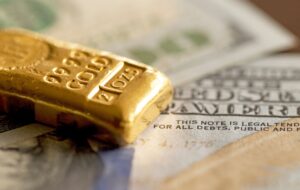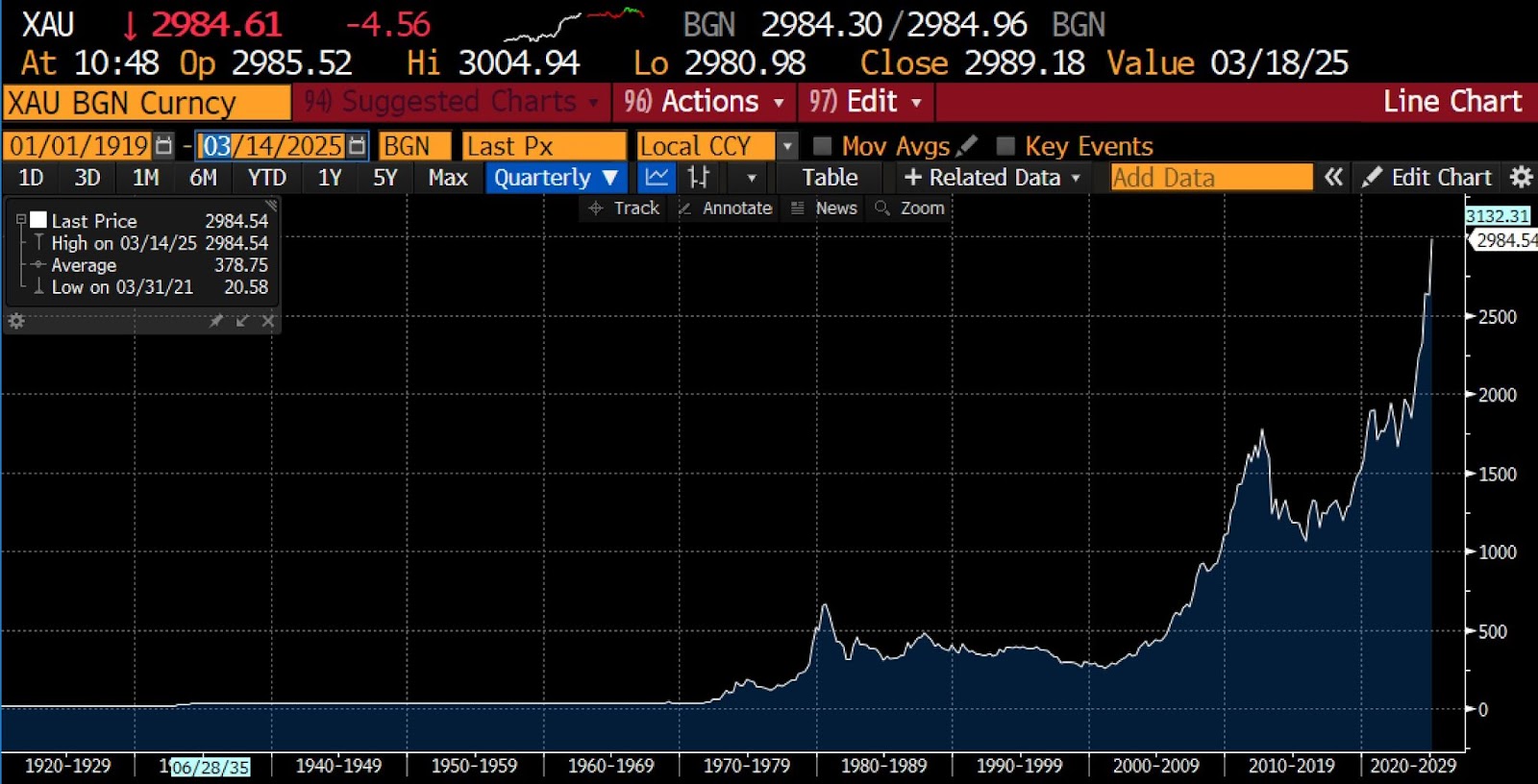
Less than a week after breaking the $2,900 per ounce barrier, gold has surged past $3,000 per ounce, driven primarily by deepening economic uncertainty. The S&P 500 has entered correction territory, tumbling over 10 percent from its recent highs as fears of a slowdown grip markets, with persistent inflation and sluggish growth stoking concerns of stagflation. Trade tensions have escalated once again, with wildly vacillating tariff threats — including a 200 percent duty on European wines and spirits — fueling uncertainty and rattling global supply chains.
Meanwhile, a growing schism in the political and military ties between the United States and Europe has added to market instability, as diplomatic fractures raise concerns over the future of transatlantic cooperation. Against a backdrop of turmoil, investors are once again flocking to gold as the ultimate safe-haven asset, pushing prices to historic highs.
For 5,000 years, gold has been a bedrock of economic commerce, a constant in the ever-shifting sands of monetary history. Era after era, it has been dismissed as an outdated relic — denigrated by policymakers, sidelined by financial engineers, and declared obsolete by the architects of fiat money — only to rise again with quiet, unshakable resilience when the grand designs of men collapse under their own weight. Time and time again, its eulogies have been written, its relevance pronounced dead, yet today, it once more stands at the center of the monetary and fiscal universe, not by decree, but by the sheer gravity of economic reality.
Central banks, once dismissive of gold, are now buying it at an unprecedented pace, seeking shelter from the very systems they helped create. Since the Biden administration crossed the proverbial Rubicon, wielding the ubiquity of the US dollar as a geopolitical weapon, nations across the world have been jolted into recognizing the peril of dollar dependency, shifting their reserves toward the one asset that history has never betrayed. Gold, indifferent to ideology and immune to the hubris of policymakers, is reclaiming its throne — not with fanfare, but with the silence of a gravitational presence that has never truly left.
Gold’s rise over the decades has been closely tied to economic crises, inflationary pressures, and geopolitical instability. Gold surpassed $500 per ounce for the first time in December 1979 as investors scrambled for safe-haven assets. The 1970s had been marked by stagflation, an oil crisis, and a weakening US dollar, exacerbated by the collapse of the Bretton Woods system in 1971. Inflation in the US had surged past 13 percent, while geopolitical events such as the Iranian Revolution and the Soviet invasion of Afghanistan contributed to economic uncertainty. These factors fueled fears of currency devaluation, prompting gold prices to soar. By the end of 1979, the metal had become a preferred hedge against both inflation and instability.
Gold price per ounce USD (1920 – present)

Gold remained below $1,000 per ounce for nearly three decades until March 2008, when the global financial crisis drove investors into safe assets. The collapse of major financial institutions like Bear Stearns and the subprime mortgage crisis led to a severe credit crunch and widespread fear of a banking system collapse. As the Federal Reserve and other central banks responded with massive liquidity injections and interest rate cuts, investors turned to gold as protection against financial instability. The metal breached $1,000 per ounce on March 13, 2008, as concerns mounted over the sustainability of the global financial system.
Just a few years later, in April 2011, gold prices surged past $1,500 per ounce as the aftermath of the financial crisis evolved into the European sovereign debt crisis. Countries like Greece, Portugal, and Ireland faced potential defaults, raising doubts about the stability of the eurozone. At the same time, the US dealt with its own fiscal struggles, including a credit rating downgrade by Standard & Poor’s in August 2011, further reinforcing gold’s role as a hedge against monetary and financial turmoil.
The next major milestone occurred in August 2020, when gold surged past $2,000 per ounce amid the COVID-19 pandemic. The global economy was upended as lockdowns, business closures, and widespread unemployment forced governments to roll out unprecedented stimulus measures, including trillion-dollar relief packages and near-zero interest rates. These efforts devalued currencies and sparked fears of inflation, leading gold to its then-record high of $2,075 per ounce.
As inflationary pressures seemed resurgent in August 2024, the gold price crossed $2,500 per ounce, driven additionally by rising geopolitical tensions, persistent inflation, and concerns over the weakening US dollar. A combination of central bank purchases, trade conflicts, and shifting global monetary policies contributed to further price gains. And now, gold has hit an all-time high of $3,000 per ounce, reflecting continued uncertainty in global markets. Factors such as renewed gold-buying by central banks, a weaker dollar, tariffs, and global economic instability have cemented — or more aptly, reminded of — gold’s role as the ultimate hedge against financial turbulence.
From this point, gold could continue to rocket north, sag back to $2,000 an ounce, or hover around its new record high before establishing a clearer directional bias as political and economic trends unfold. What is certain, however, is that gold has consistently met the rare set of criteria that make it the soundest (according to the market as experienced in real life) form of money in human history. And just as certain, that truth will continue to be doubted, dismissed, and ultimately reconfirmed, as long as ambitious, power-seeking individuals attempt to manipulate the systems in which it operates. Reality will inevitably prove them wrong, again.
